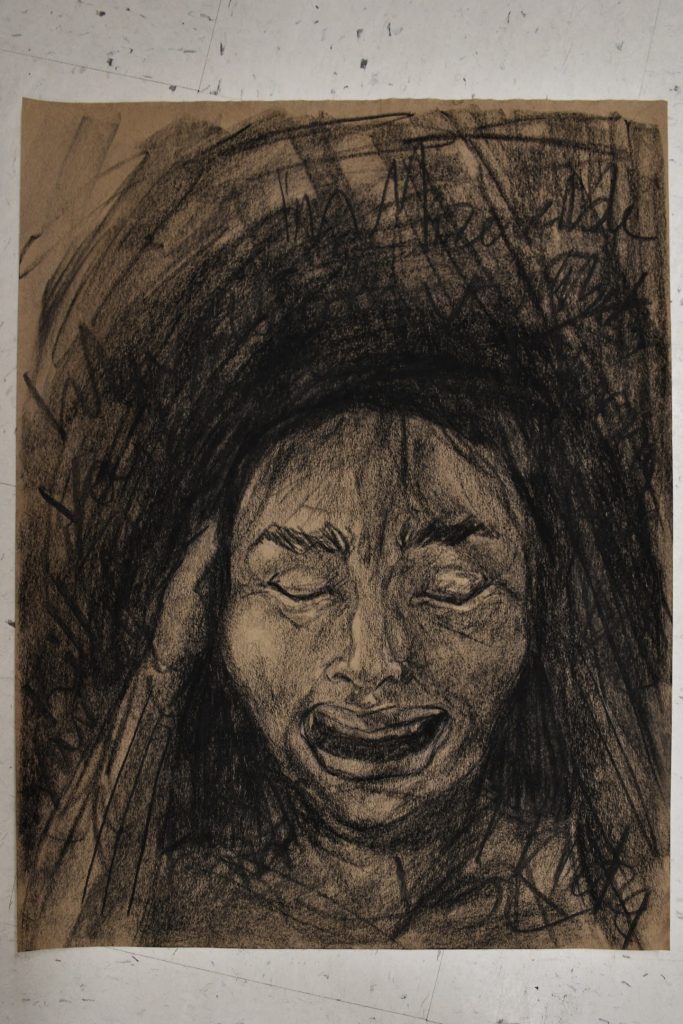Kelsea Vance
Cassidy Picken
English 100
04 December 2019
A Product of Narcissism: A Triptych
An important differentiation to make between high self esteem and narcissism is that “High self-esteem means thinking well of oneself, whereas narcissism involves passionately wanting to think well of oneself”(Bushman 220). A crucial differentiation between a mental illness and an inflated ego. This triptych expresses the emotional journey of a child of a narcissistic parent. Reading many accounts of people with similar experiences a common emotional thread ties us together. Two emotional stepping stones surround the centre figure and while they lie in the back of her head, clarity and perseverance has been achieved to some degree.
Despair (1)
Despair illustrates the devastated self image narcissistic parenting breeds. Drowning in thoughts of self harm and desperation, despair leads to either action or something much darker. Psychology today lists detrimental phrases that are commonly said to many children without any regard for the impact these words carry. Manipulative phrases such as: “You’re the reason I’m miserable” or “I’ve done everything for you and you’re so ungrateful”. I chose to etch these specific phrases into the piece as they’ve stuck in my mind the minute they were said to me. In these families, parents shame the child, saying words such as: “I let you live in my house”. Other manipulative behaviour commonly found is guilt tripping or shaming, ex. food, clothing, or a home are not rights but rather luxuries in these relationships.
Placing the figure lower in the piece makes them smaller than the darkness around them and compositionally speaks to the loneliness felt. This also resonates with The fact that, “a narcissistic mother or father might make a concerted effort to put the child down, so the parent remains superior”(Ni, Section 2). Being the only piece with the eyes shut, it represents a damaged self image children of these families produce.
Rage (3)
Representing the common emotion that accompanies despair, rage is meant to communicate the blame and anger directed towards narcissistic parents after realization of the mistreatment. While not an entirely healthy state of mind, rage inspires action and demands change.
The figure is slightly higher in the composition now, taking centre stage in their life. A hand grabs the figure’s neck trying to stifle a growing self image and tying them down. The hand is intentionally lighter than the rest of the piece to signify its importance in relation to adolescence. Brushed off and belittled as a rebellious phase, Rage intends harm and believes in an eye for an eye.
An emotional piece illustrating my early teenage years and an incident between my father and I.
In Origins of Narcissism in Children, under significance, Eddie Brummelman states that narcissists “feel humiliated, they often lash out aggressively or even violently”(3659). Older generations brush off young people reaching out as being too sensitive and this continues the cycle of abuse.
Now What (2)
The centerpiece of the triptych illustrating where I stand emotionally today. Now What abandons the anger of Rage and the helplessness of Despair in an attempt to move forward. Recognizing she is a product of her environment Now What is at a crossroads. Where the stages of grief have a conclusive end, the healing process in situations like these are not so easily guided as many narcissists cannot see their shortcomings. Therapy often doesn’t work regarding narcissism as one has to want to change to see any progress. I chose not to include a question mark as I want it to feel like a command rather than a question. I want to resolve my trauma. I want to move forward. I’m desperate for a way through but through my research I understand that it may never be resolved and I have accepted the possibility.
Works Cited
Bushman, B. J., & Baumeister, R. F. (1998). Threatened egotism, narcissism, self-esteem, and direct and displaced aggression: Does self-love or self-hate lead to violence? Journal of Personality and Social Psychology
Brummelman, Eddie, et al. (2015). Origins of Narcissism in Children. Proceedings of the National Academy of Sciences of the United States of America, https://www.pnas.org/content/pnas/112/12/3659.full.pdf
Ni, Preston. (2016). 10 Signs of a Narcissistic Parent. Psychology Today, Sussex Publishers, 2016, https://www.psychologytoday.com/ca/blog/communication -success /201602/10-signs-narcissistic-parent.



